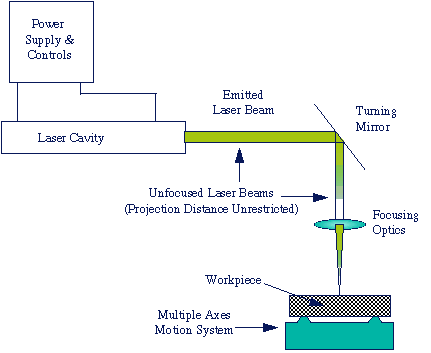|
laser beam 용접
Laser welding is a high energy beam process and in this regard is similar to electron beam.
With that exception they are unlike one another. The energy density of the laser is achieved
by the concentration of light waves not electrons. The laser output is not electrical,
does not require electrical continuity, is not influenced by magnetism, is not limited
to electrically conductive materials and in fact can interact with any material whether it be metal,
plastic, wood, ceramic, etc. Finally its function does not require a vacuum nor are x-rays produced.
 The focal spot (thousandths of inches in diameter) is targeted on the weld joint surface or
by focal length selection above or below it. At the surface the enormous concentration of
light energy is converted to thermal energy. Surface melting occurs and progresses through
the weld joint by thermal conductance. For welding, beam energy is maintained below the vaporization temperature
of the weld joint material. For hole drilling or cutting vaporization is required.
Because weld joint penetration is dependent on conducted heat the thickness of materials to be welded
is generally less than .080 inches if the ideal metallurgical and physical characteristics of
laser welding are to be realized. These benefits are narrow welds, no distortion, minimal heat affected zones
and excellent metallurgical quality.
The focal spot (thousandths of inches in diameter) is targeted on the weld joint surface or
by focal length selection above or below it. At the surface the enormous concentration of
light energy is converted to thermal energy. Surface melting occurs and progresses through
the weld joint by thermal conductance. For welding, beam energy is maintained below the vaporization temperature
of the weld joint material. For hole drilling or cutting vaporization is required.
Because weld joint penetration is dependent on conducted heat the thickness of materials to be welded
is generally less than .080 inches if the ideal metallurgical and physical characteristics of
laser welding are to be realized. These benefits are narrow welds, no distortion, minimal heat affected zones
and excellent metallurgical quality.
As with electron beam the intense, concentrated energy produces melting and coalescence before a substantial
heat affected zone can develop. Because the welds are narrow and therefore are of correspondingly low volume
there is a minimal reservoir of heat for conductance into the adjacent area. When materials to be welded are
thick and particularly if they have high thermal conductance (aluminum for example) this important
metallurgical advantage of minimal heat affected zone can be detrimentally affected. It is claimed
that since the source of energy is light of a specific wavelength contaminants in the weld pool or
on the facing surfaces of the joint may be preferentially vaporized by their particular light absorbing
characteristics resulting in a kind of weld purification. The excellent fatigue strength of laser welds
is sometimes attributed to this purifying phenomena.
Energy distribution across the beam is generated by the design of the resonant cavity, including mirror curvatures
or shape and their relative arrangement. This combination results in photon oscillation within
the cavity producing specific output beam energy distribution or patterns. These patterns are
labeled transverse energy modes (TEM) and have specific identifying numbers. We cannot within
this seminar describe their variety and effects. However, we will point out that the Gaussian mode
TEM 00 is often preferred for welding inasmuch as its peak energy is in the center of the beam feathering off
to its periphery. It might be likened to a pointer. The symmetry and profile of the Gaussian Beam is
particularly suited for welding.
We have learned how light energy is amplified in the solid state laser cavity and how the laser beam
and its unique characteristics are formed. It is important to note before proceeding that the function
of all lasers whether they be gas (carbon dioxide, helium neon, etc.) or other lasing sources is based
on the principle of the excitation of atoms by means of intense light, electricity, electron beam,
chemicals, etc., and the spontaneous and stimulated emission of photons. Depending on the lasing source,
output frequencies differ widely and are capable of widely differing applications. This range can vary
from welding to critical surgery, resistance trimming, communication, etc.
As an obvious demonstration of the effect of light wave frequency the beam of a neodymium YAG laser
(l.06 microns wavelength) will pass through quartz lenses, clear plastic or glass and
other translucent materials. However a carbon dioxide laser emitting a beam of 10.6 microns wavelength
will not pass through the quartz lens etc. but rather will be absorbed by those materials resulting
in their destruction. Carbon dioxide lasers must achieve focusing either by converging,
reflecting optics or special salt based lens materials such as zinc selenide.
# From Joining Technologies
|